Table of Contents
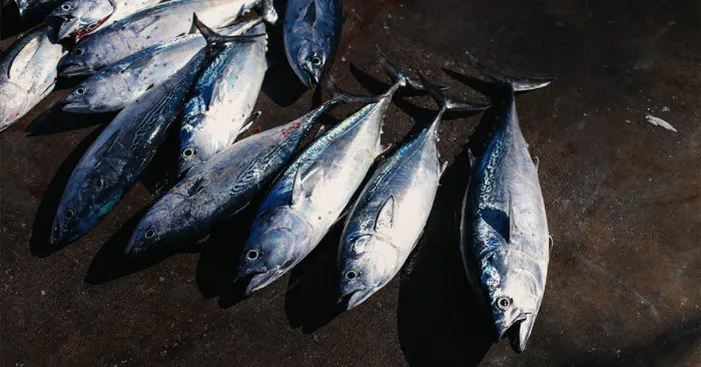
Tuna types are very different in terms of size, shape, color, habitat, and taste!
In terms of US seafood consumption, tuna comes in 3rd place right after shrimp and salmon. (1)
Tuna accounts for about 6% of the world’s seafood consumption which is 5 million tons. (2)
However, the name tuna covers many types of this fish and some of them are not subject to the same exploitation.
Thus, it can be a little confusing to choose the best tuna to consume based on taste and endangerment.
In this article, we gathered a lot of useful information based on respectful sources to help you learn more about the 6 most consumed types of tuna.
Tuna overview:
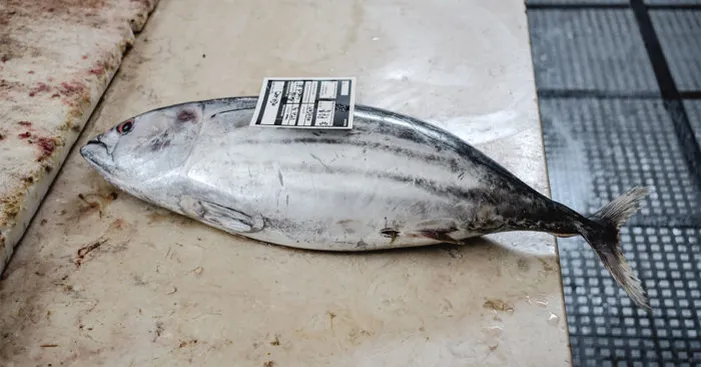
The word “tuna” describes 15 different types of this fish but only 3 to 4 tuna types make it to our kitchen. (3)
The order of the six consumed tuna fishes based on least to most fished is:
- Bluefin tuna.
- Dogtooth tuna.
- Blackfin tuna.
- Yellowfin tuna.
- Bigeye tuna.
- Skipjack tuna.
There are many fattening farms that capture and then feed the tunas to get fatter.
Nonetheless, fattening farms are mostly exclusive for Bluefin and only cover a small percentage of the market needs.
The majority of tunas are captured by fishing and recently some species have become more endangered because of that.
In 2016, 10% of tunas were captured in the Atlantic Ocean, 21% in the Indian ocean, and 70% in the Pacific ocean. (4)
Due to the short lifespan of fresh tuna, 60% of the tuna production is for canned tunas as that allows a longer lifespan and easier shipping.
The main species of tuna marketed and how to better choose them:
Tuna types:
Blackfin tuna:
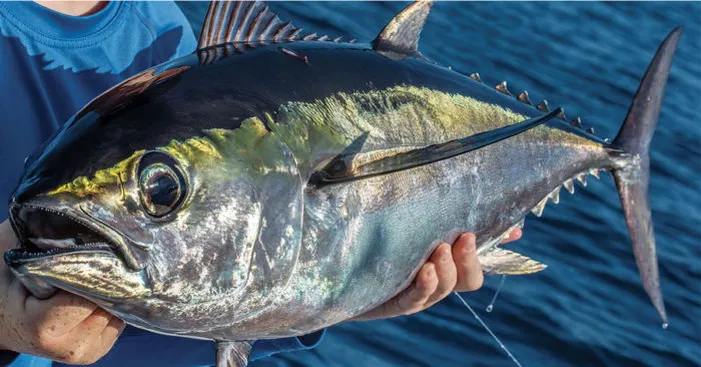
The longest blackfin tuna recorded was only 42 inches (108 cm) and 45 lbs (20.6 Kg) which makes this type one of the smallest tunas. (5)
The average size of this tuna is usually 28 inches in length and 15 lbs (6Kg) in weight and it lives for up to 5 years.
It has a unique black back that fades to white towards the belly.
This type lives exclusively in the Atlantic Ocean in the region between North Massachusetts and South Rio de Janeiro-Brazil. (6)
It can live in water depth between 60 and 2300 ft.
Catching blackfin tuna in South Florida is a very famous activity, as the fish put up a fight and of course let’s not forget, their taste is really delicious!!
This tuna has been the main idea for several dishes as it is perfect for sushi, sesame seared or you can even just boil it and use it to make a tasteful tuna salad!
Skipjack tuna:
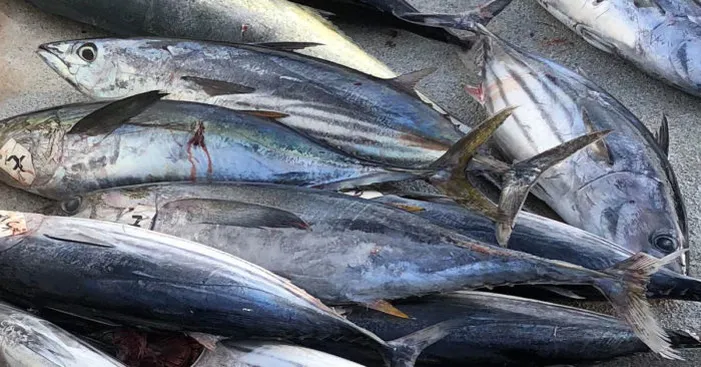
This type has stripes along its belly that’s why it’s called “thon à ventre rayé” which means “tuna with a striped belly”!
Skipjack tuna mature rapidly and can grow in length for up to 3 feet.
It also exists almost everywhere but that makes it the most captured type around the world.
In fact, Skipjack tuna is the most common type of tuna worldwide and it represents 58% of the world’s catches. (7)
Since the year 2000, we consume almost 2.5 million tons of skipjack tuna every year worldwide.
However, the vast majority of it arrives at our tables mainly canned.
Skipjack canned tuna is usually labeled as “light” and it has a very strong fishy taste compared to other types of tuna. (8)
This makes it perfect for pasta, salads, and casserole as it adds that rich fish flavor.
It is first cooked, trimmed, seasoned then canned, and shipped to the markets.
It is also used in many other dishes like the Japanese Katsuobushi.
They dry the skipjack tuna, wait for it to ferment, and finally smoke it, Voilá! The famous Katsuobushi of the Japanese cuisine is ready!
Advantages:
- Grows particularly quickly and reproduces rapidly.
- Low-fat content (1g per 100g) offers a lower risk of contamination as toxins are mainly found in fat tissue.
- Fishers mainly use safe fishing methods that preserve endangered species.
Skipjack is the most preferred type of tuna thanks to its rapid growth and delicious taste if it’s fresh or canned.
However, always make sure you choose skipjack tunas with the label “MSC” which guarantees sustainable fishing that doesn’t endanger species. (8)
Yellowtail tuna:

The scientific name is “Thunnus albacares” but people call it different names: yellowtail tuna, yellowfin tuna, or just yellow tuna.
This fish can reach a length of 7 ft and weigh around 500 pounds but it is still smaller than the Bigeye tuna and the Atlantic Bluefin tuna.
Yellowfin tuna comes to our kitchen in the form of steaks, fillets, or canned.
Larger than skipjack, yellowfin tuna is the second most popular tuna as it accounts for 28% of the market. (9)
Advantages:
- Lowest fat content (0.94g per 100g).
- Least concerned according to the IUCN (International Union for Conservation of Nature and Natural Resources). (10)
Disadvantages:
- Not necessarily less risk of contamination as it lives longer and though more likely to accumulate of toxins.
- Captured by overfishing techniques that endanger other aquatic species (dolphins, sharks…).
Because of the overfishing of yellowfin tuna, try to choose MSC labeled (certified sustainable) fish that are captured with approved fishing methods.
This type of tuna can be prepared in different ways, one way is it can be cut into steaks and we all know how delicious tuna steaks can be when roasted with olive oil, garlic, and pepper!
One thing about seafood and mostly tuna, they can be eaten half-cooked or even raw.
That applies to the yellowtail tuna as well, it can be eaten raw or half-cooked.
Just like skipjack, the yellowtail tuna is mostly canned but it is sometimes used raw (for sushi) or smoked.
If you want it half-cooked, 2 minutes on a high heated pan for each side is enough to have that golden crispy skin while still tender on the inside.
As for the canned yellowtail tuna, it is perfect for salads, pasta, gratins, or quiches …
Big eye tuna:
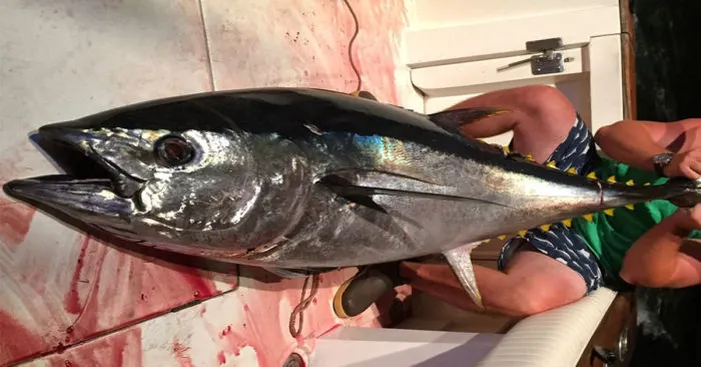
Despite the name, this type is hard to distinguish from the yellowfin tuna.
Big eye tuna have big eyes and a chunky shape which is why its scientific name is “Thunnus obesus” which means “obese tuna”!
This tuna is very famous in Hawaii actually they have their own name for it, they call it: Ahi! (11)
It has very long belly-fins and yellowfins on its back and tail that fade to black towards the ends.
Found mostly in tropical waters, big eye tuna lives in deeper water, compared to other types of tunas, alongside whales and sharks.
It lives between 8 and 14 years and reaches 7 ft in length and weighs 230 pounds.
Third type in terms of consumption after skipjack and yellowfin, Bigeye tuna accounts for 7% of the global production. (12)
Disadvantages:
- High mercury levels due to its long lifespan which is double that of other types of tuna.
- “Vulnerable species” according to the IUCN.
When you are buying fresh tuna, try to avoid buying Bigeye tuna and go for skipjack or Bluefin tuna types.
If you want to try Bigeye tuna make sure you limit your consumption because of its high risk of contamination.
The big eye tuna has a high level of fat content with a richer flavor compared to yellowfin tuna.
That makes it perfect for Sashimi as the flavor is intense and the texture is firm and resembles meat!
Other Japanese dishes also use the big eye tuna including the famous sushi!
Dogtooth tuna:

This tuna earned its name because of its mouth, it is among the Scombridae a family of fish characterized by powerful jaws.
When it opens its mouth, the dogtooth tuna reveals 50 pointed canine teeth that resemble the ones of dogs.
In the scientific field, it goes by the name “Gymnosarda unicolor” and it lives mostly in the Indian Ocean. (13)
It can measure up to 9 feet in length and weighs almost 300 pounds.
The dogtooth tuna inherited an aerodynamic body which allows it to be a super-fast fish and can reach up to 50 miles/hour!
In terms of color, this type of tuna has a purplish-blue color with a silvery tone on the sides and belly.
Compared to other types of tuna, dogtooth has a mild taste and is less dense.
In fact, it is 15% lighter in weight than longtail tuna that have the same size!
Japanese use this fish to make delicious sashimi that is lighter because of the firm and light texture of dogtooth tuna.
Basically like most steaks, this tuna is recommended to be grilled, pan-fried, ceviche, and smoked as well!
Bluefin tuna:
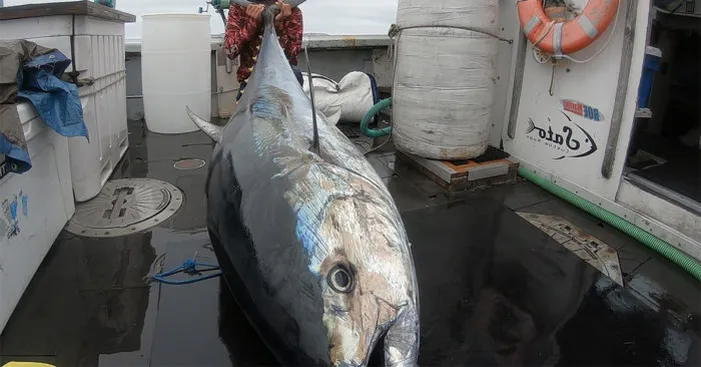
As the largest type of tuna, the Bluefin can reach the same size and weight as a male white shark, and is slightly smaller than Beluga whales or Killer whales, crazy right! (14)
This tuna can live up to 35 years and reaches 12 feet long and 2000 pounds in weight.
That makes it the favorite food for most ocean predators including the great white sharks and killer whales.
Bluefin tuna count for only 1% of the global tuna production probably because it’s the most expensive fish per kg.
Due to excessive fishing, the Bluefin is one of the symbols of close-to-extinguish marine resources.
As we all know, the Japanese rely on seafood for their daily nutrients and the consumption of Bluefin tuna is very famous there.
In fact, it is the tuna they use for their famous Sashimi and Sushi dishes.
The expensive price is mostly because of the over demand especially from Japan’s governments as it pays high prices to satisfy the local market.
Did you know that they consume 80% of the Pacific and Atlantic Bluefin tuna caught worldwide?
Advantages:
- A large size that offers a large number of fillets per fish which making it very profitable.
- moved from “Endangered species” to “Least concerned” according to the IUCN . (15)
Disadvantages:
- Contains 6 times more fats than a skipjack tuna (7g per 100g) thus a higher risk of contamination.
- Cause weight gain mostly due to the fat content.
- Very expensive (200 to 400$ per pound)
You may try Bluefin tuna once for the sake of trying, but probably not the best type of tuna to buy if you consume tuna often.
References:
(1): Behind the Scenes of the Most Consumed Seafood | NOAA Fisheries
(2): Tuna – World’s Most Consumed Fish | Pages| ATUNA
(3): FIRMS – Marine Resource fact sheets – Tuna and tuna-like species – Global (fao.org)
(4): Netting Billions: A Valuation of Tuna in the Western and Central Pacific Ocean | The Pew Charitable Trusts (pewtrusts.org)
(5): Thunnus atlanticus, Blackfin tuna : fisheries, gamefish (fishbase.se)
(6): https://guidesly.com/fishing/fish-species/blackfin-tuna#:~:text=Blackfin Tuna Habitat and Distribution,oceanic waters near the coastline.
(7): FAO Fisheries & Aquaculture – Fishery Statistical Collections – Global Tuna Catches by Stock
(8): What is tuna | Sustainable fish | Marine Stewardship Council (msc.org)
(9): Tuna Fish Market By Species & By Type | Forecast [2021-2028] (fortunebusinessinsights.com)
(10): Tuna species recovering despite growing pressures on marine life – IUCN Red List | IUCN
(11): Bigeye Tuna (Ahi) – Hawaii-Seafood.org
(12): Price+structure+-+canned+tuna+in+Spain.pdf (eumofa.eu)
(13): Gymnosarda unicolor, Dogtooth tuna : fisheries, gamefish (fishbase.de)
(14): Atlantic Bluefin Tuna (oceana.org)
(15): Tuna species recovering despite growing pressures on marine life – IUCN Red List | IUCN
